Chickens for the Orchard (Part 2)
- Bill Wilson
Part 3: 8-13 Weeks of Age (As Adventurers)
Part 2: 4-8 Weeks of Age (As Kids)
Part 1: 0-4 Weeks of Age (As Chicks)
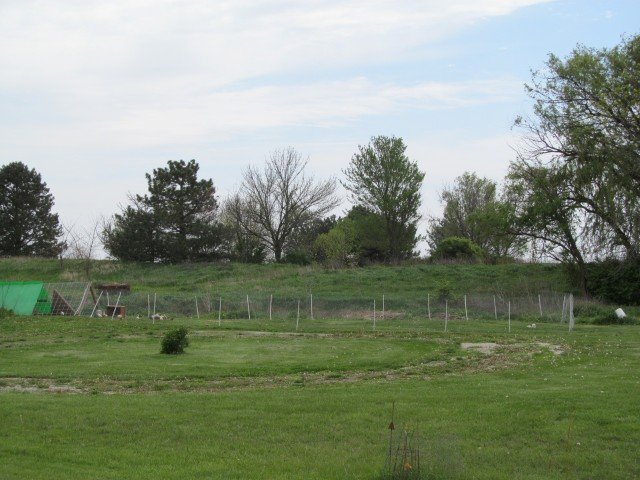 |
| This is where we ended in the first blog post of 3 weeks ago. We had just moved the 4-week old chicks to the orchard to begin the process of weaning them from ‘chick’ feed and encouraging them to eat the grass, weeds, and bugs in the orchard for daily sustenance. |
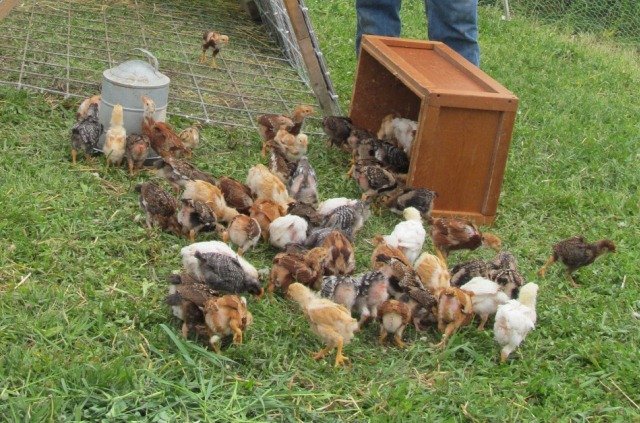 |
| From the moment the chickens hit the grass, they were eating everything they could peck at and swallow. They seemed to visibly grow almost daily even though the amount of feed we were giving them did not increased since we brought them to the orchard. Each day they are getting more and more of their food and nutrition from the orchard floor. We’ve even seen them catch flying insects. |
| |
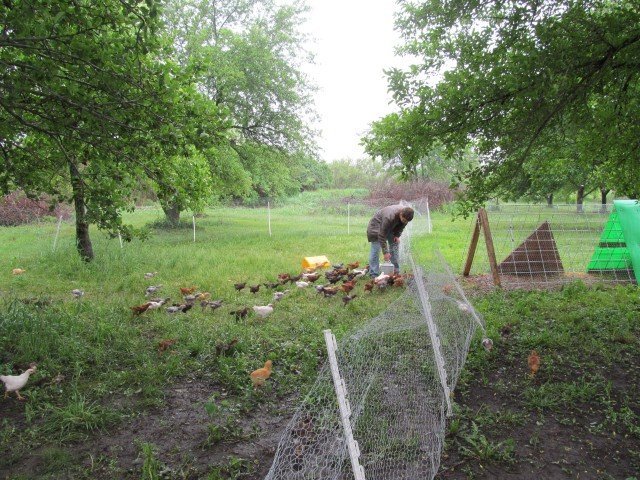 |
| Within 1 week we moved our experimental chicken coop and the 150-foot chicken wire fence into the heart of the orchard to get them more familiar with their new habitat. Within 3 days a few of the birds started getting out of the fence so we deemed it time to take the big risk and open the fence permanently. |
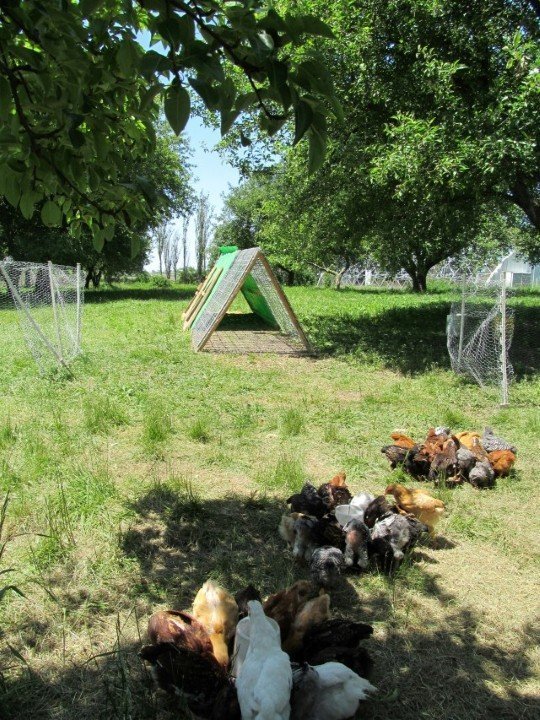 |
| For over a week, the fence stayed up, but open — and each night everybody returned home for bed a dark. To our knowledge, we have not lost one bird yet. Feeding time still seems to be the highlight of their day (around noon and only once a day) but when their trays are empty they are back into the orchard for more treats and sustenance. |
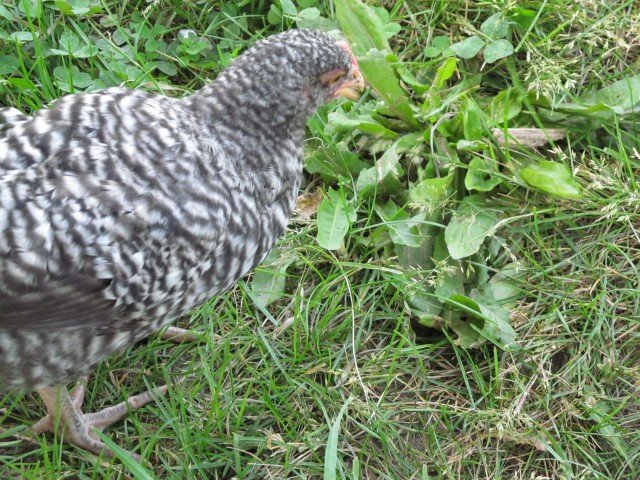 |
| The one food they seem fondest of (besides the worms and bugs) are the newly-forming grass-seed heads. Second are the tender broader leafed ‘weeds’ like clover and dandelion. |
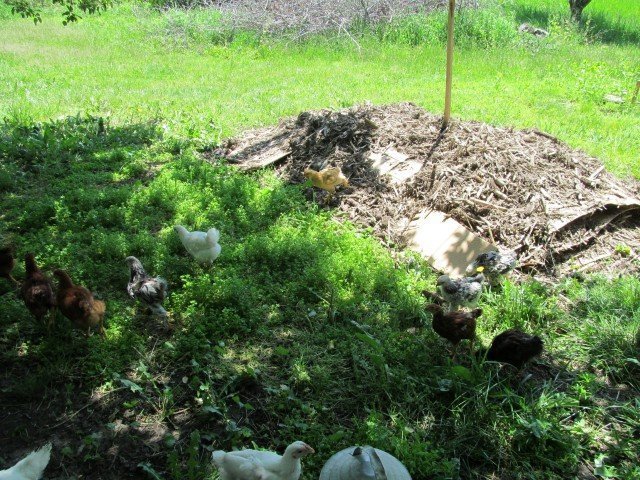 |
| What we hope will become a big source of food are these ‘cricket condos’ that Hayden and Cameron have built. These are a form of sheet mulching. We laid down three layers of cardboard with grasses and other bulky material slid in-between each layer. We built something similar last year and at one point, every time we passed it, crickets would come popping out of it…by the hundreds…!!! Using the permaculture principles of “Observer and Interact” and “Stacking Functions” we simply are taking advantage of the obvious. And to add icing to the cake, when the chickens are gone, the piles will break down into a beautiful bed where we are planning to develop our food forest understory. What’s not to like? |
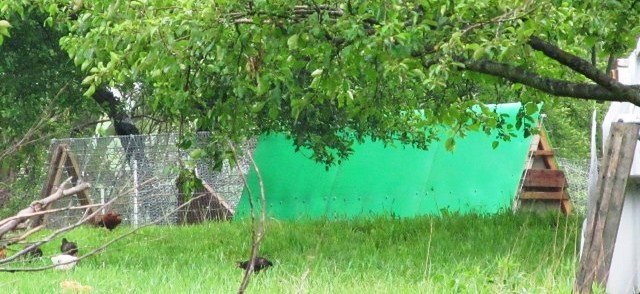 |
| Along this same line of thinking, this is the reason that we created an open floor of chicken wire for our newly designed chicken coop. |
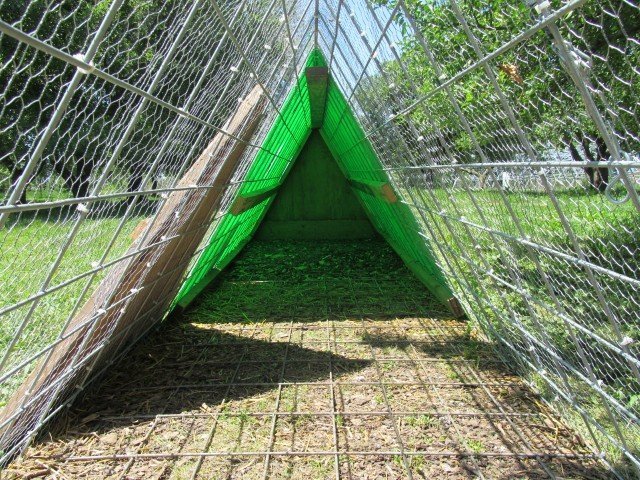 |
| As you can see, the chicken wire was wrapped all of the way around the coop on the open end (and across the floor on the sheltered end). |
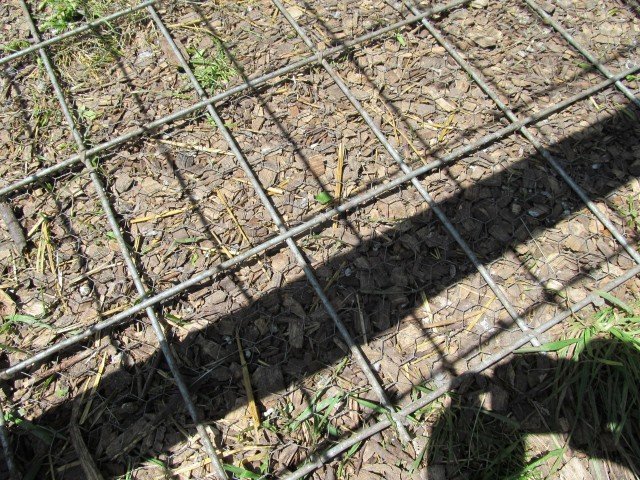 |
| The bedding material we decided to use is woodchips. The reason for this is that even though we may throw in some fresh chips each day to minimize nitrogen build-up from the chicken poop, the chips sift through the floor with just some shaking of the coop and over time we end up building a solid bed of fertilized-woodchip mulch. |
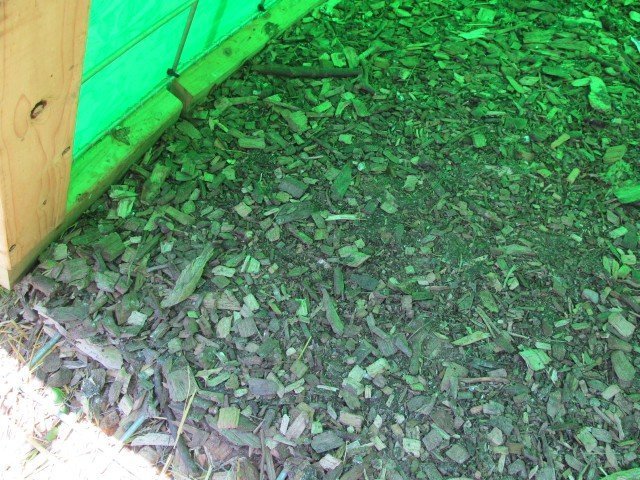 |
| When the next batch of birds comes along, we simply pick up the coop, sifting out all of the remaining woodchips before we move it, and allow this remaining mulch-pile to break down slowly. This will fertilize our fruit tress while also preparing another bed for the new understory of perennial plant we will be putting in to help build our budding food forest. Once again… we’re just stacking functions. Why should we move fertilizer and kill grass to build a new bed in the orchard…when the chickens will do it for us for free. |
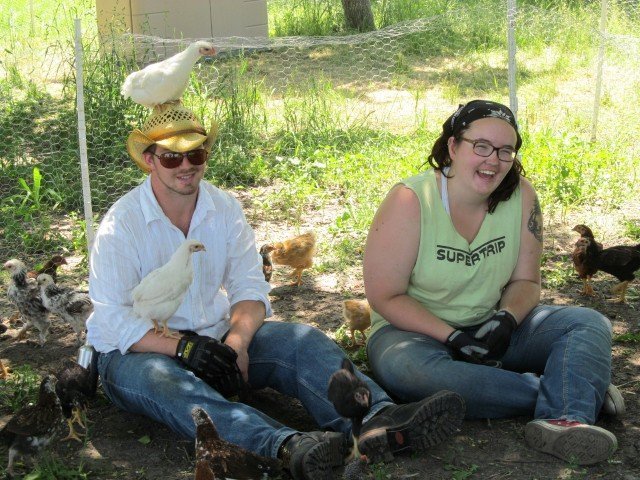 |
| As you can see, the birds are getting bigger and becoming quite fond of Hayden and Cameron. The two of them are enjoying this entire process as well. Even though these are meat birds, they are living a very full life as chickens, able to express their full ‘chickeness’. Compare this to industrial raised birds that never see sunlight, grass or bugs. As meat eaters, which bird would most of us rather eat? |
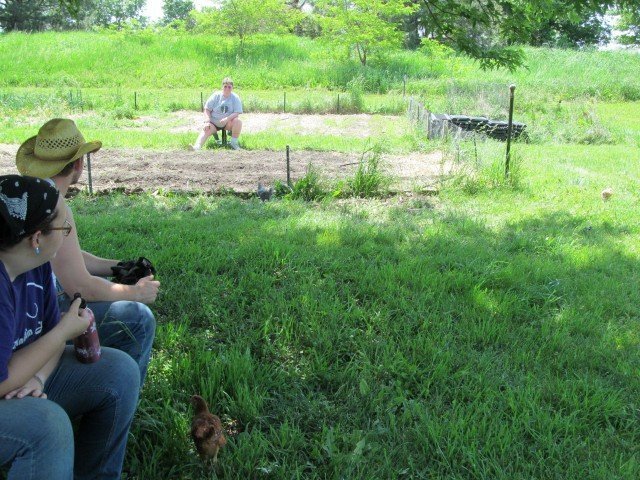 |
| Today however (May 18th, 2012) marks a new chapter in the life and care of these birds. Peg, Hayden and Cameron were working down in the garden this morning when all of a sudden…. chickens started to appear….and appear…and appear. |
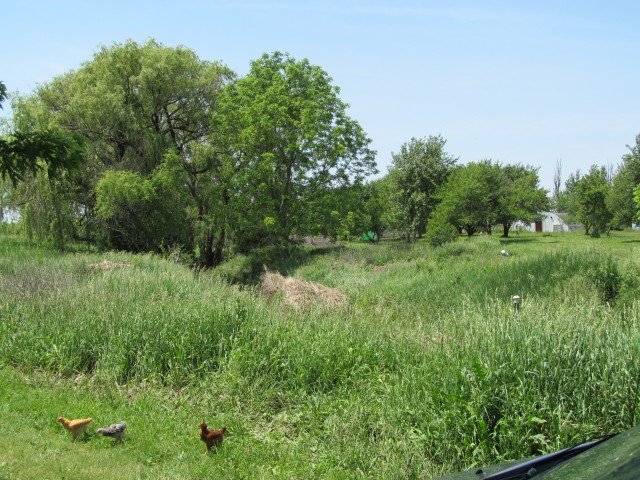 |
| The little buggers figured out how to cross over our little creek and make there way through the tall grass to get to our interns and the company they enjoy. |
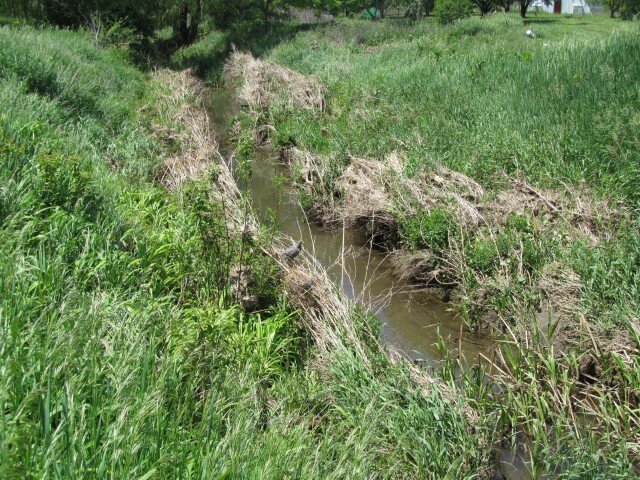 |
| The ditch is quite deep and the grass quite tall, but across they came. |
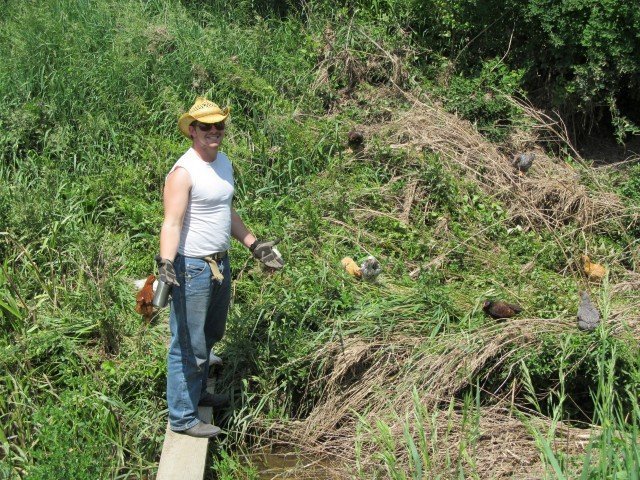 |
| Something that helped is the small board-bridge that Hayden uses, but many just found their way through the grass regardless. Since Hayden is like the pied-piper to them we thought that maybe they would follow him back to the orchard if he encouraged them along. |
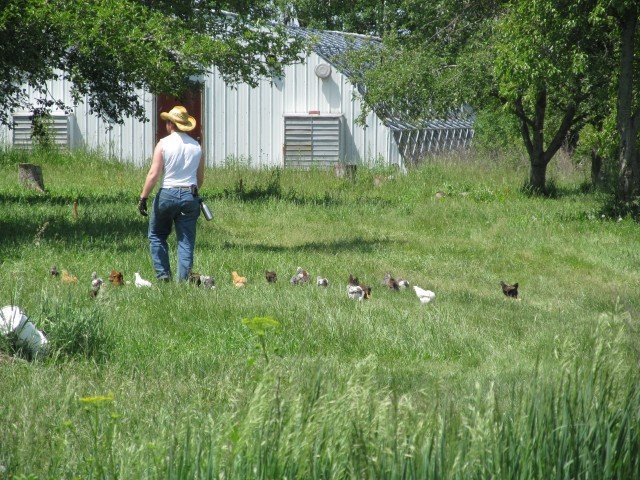 |
| So, across he went and yes… some did follow him. But most did not. |
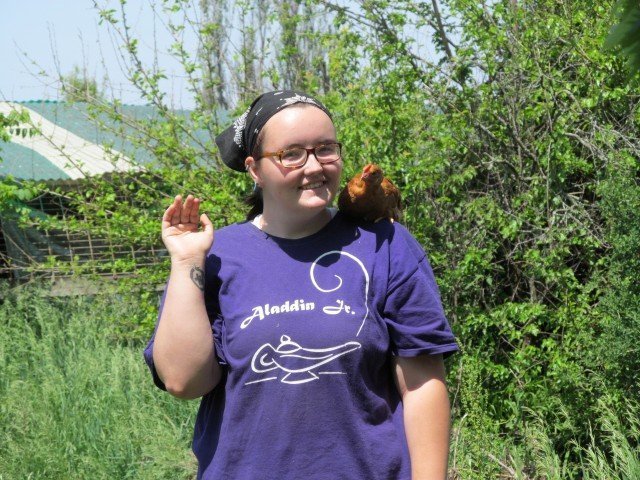 |
|
Tonight will be the big test — can they all find their way home, back across the creek, and return to the safety of their coop by nightfall? By the time we post here again in 4 more weeks, it will be harvest time. We have mixed emotions about that. Bill |
Next Morning Note: Everybody found their way home and had tucked themselves into bed for the night. Whew…!
|
Interested in visiting Stelle and seeing our chicken venture up close? We just decided that we would make our afternoon, July 15th Open House seminar , hosted by our local non-profit Center for Sustainable Community, all about this chicken venture. Come and examine the coop, the cricket condos, the woodchip chicken-poop bed, and ask all the questions you like while meeting our work/study interns. July 15th, 2012 — CSC Open House 1. Introduction to Stelle, from 10:00 – 11:00 (Free)
2. Community walk-about, from 11:00 – 12:00 (Free)
3. Lunch ($10)
4. Chicken Project Seminar ($15 Adults – $5 Children 15 and under)
I (Bill Wilson) will be your host for the day and our interns will assist with the afternoon seminar.
Hope to see some of you…. Bill Wilson
Call 815-216-4124, message or text us at 815-782-22162204 or email CSC (csc@stelle.net) to register.
Here are the Directions and Maps to Stelle
|

8 thoughts on “Chickens for the Orchard (Part 2)”
What’s the latest on the chickens?
Thanks for asking Sharon… Hope to post an update this week. We have been gone for two weeks and are catching up now…
I’m glad to see they are doing so well. One would think that the predator’s might want a tasty snack. Do you have any thoughts about that?
Good to hear from you Larry.
We think about predators all the time and wonder why we are not having any challenges as of yet. We took the time to build the coop to make it as secure as possible, but the kids are out all day long and would be easy prey for hawks and coyote. Knock on wood… no losses yet.
My best guess is that due to the fact that they are in our orchard, there is almost always cover over their head (makes it difficult for hawks to swoop down) and plenty of branches to fly up into (should a dog or coyote come along). They still have 4-8 weeks to grow so we shall see how things go.
There should still be some around when you come down for the PDC course Larry.
Look forward to seeing you again… Bill
Cliffhanger! I tried to Like your Facebook page but it wasn’t allowed. Now I’m left wondering if they made it back, but my guess is that they did. I love what you’re doing with them, and I’m fascinated by your methods. I started gardens last fall with carboard and manure and shredded leaves and such. It turned out great mostly but some areas are teaming with those bugs that roll into a ball when you touch them. The chickens aren’t interested in these. Any thoughts on went some areas have giant earth worms and some these things?
Hi Sharon… thanks for reminding me that we needed to let folks know if the chicks made it home. They did, and everyone seems a little more grown up, now that they have explored the greater boundaries of the world.
I think of garden soils as having personalities. Some respond to certain things and others do not. And how someone/something appears does not often reflect what is going on underneath. So… when you get different results in the garden see it as a one time event and look at how you plan to build your soil over the decades. The one thing we can all do that almost certainly always produce positive results is to add organic matter…organic matter… organic matter.
Thanks for the comment…. Bill
ES LO MEJOR,PARA EVITAR EL ESTRES EN LOS POLLITOS Y DARLES MEJOR CRECIMIENTO
From google translate: IS IT BETTER TO AVOID STRESS IN THE CHICKS AND GIVE THEM BETTER GROWTH?
If we maximize the chickens growth we do so at the expense of other services they provide. One of the goals for the chickens is to have them weed and provide pest control for the orchard, simultaneously reducing the cost of feed. It may take longer before the chickens get to their maximum size, but they will be more useful to the overall system. Besides, which is more stressful: having all the yummy bugs and greens you want to eat or a diet that is designed to fatten you up?